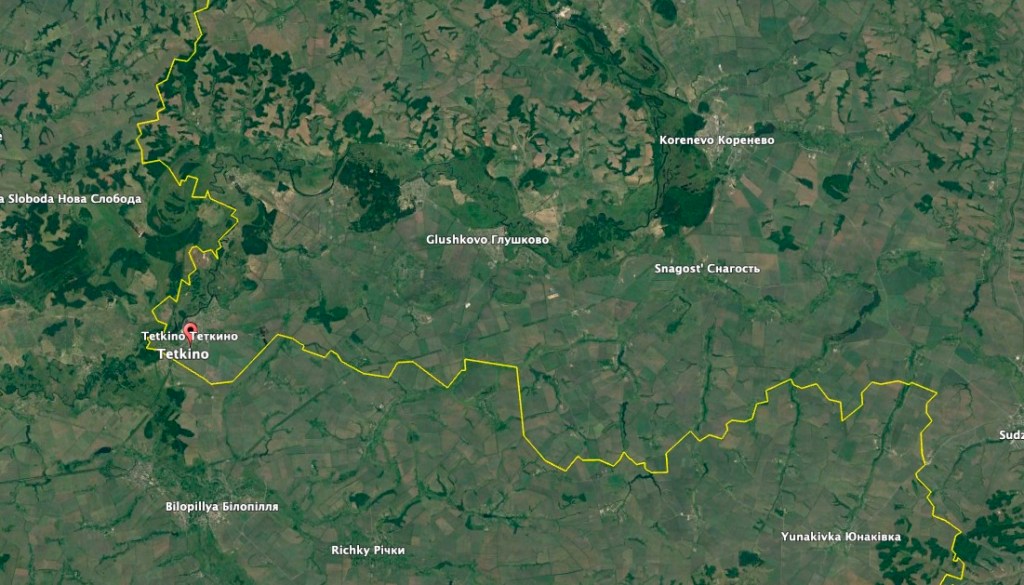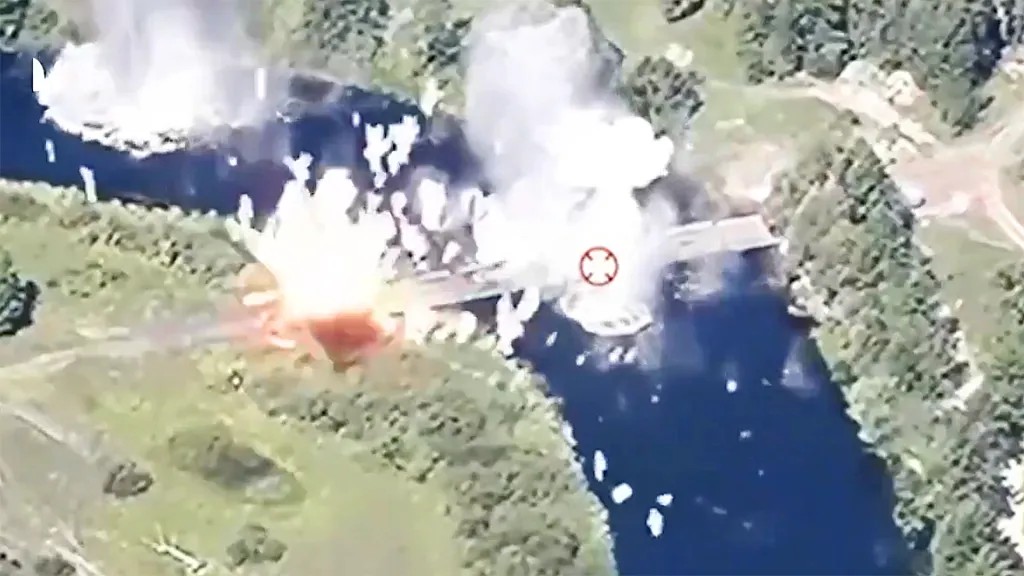With as many as 3,000 Russian troops still trapped south of the Seim River in Kursk on the 16th day of the invasion, Ukrainian forces have reportedly begun probing attacks near the town of Tetkino, which is on the western edge of that sector. As we explained yesterday, by pushing east from there, Ukrainian forces could catch the Russians in a pincer as they also move west from the edge of their Kursk salient.
“Ukrainians quickly captured the western bank of the Seim River in its entirety, as well as numerous positions in the town itself,” Euromaidan Press reported. “On the western bank, Russians quickly retreated back to the settlement and blew up two minor crossing points as soon as Ukrainians launched their attacks.”
That move “temporarily secured the Russian northern flank against Ukrainian assaults,” the publication explained. However, “the Russian southern flank remains completely open. With the initial intensity of Russian resistance in Tetkino being small, Ukrainians will likely soon launch a second offensive and add over 600 square kilometers of Russian territory to their current gains.”

The Kremlin-connected Rybar Telegram channel has a different take, saying that Ukraine is hitting Tetkino “from time to time” with artillery, but has yet to advance across the border there.
The Russian forces are trapped south of the Seim River because Ukraine blew up three bridges. Yesterday, we wrote about how pontoon bridges Russia is building to help those troops will become likely targets from Ukrainian aviation, artillery, and drones. One Russian milblogger wrote today about the difficulties of this operation.
“Now the Ukrainian Armed Forces are concentrating on the removal of the crossings, which our heroic pontooners, with the tenacity of the doomed, are building,” Reporter Rudenko V wrote on Telegram. “Among journalists, filming the building of pontoons has always been something secondary. But today this work is mortally dangerous in the full sense of the word. They are being covered both on marches and in the area of building the crossing.”
Today, new video emerged showing those make-shift spans and equipment near them being struck by cluster munitions. You can see the submunitions widely scattered around the bridge and other targets.
The Russian Defense Ministry (MoD) has yet to address the situation south of the Seim River but continues to say that it is pushing back Ukrainian troops in Kursk.
“Units of the Sever Group of Forces supported by Army Aviation and artillery have thwarted attacks launched by enemy assault detachments in the direction of Komarovka, Korenevo, Malaya Loknya, and Russkaya Konopelka,” the MoD claimed on Telegram. “The Armed Forces of the Russian Federation continue reconnaissance and search operations to locate and eliminate the enemy small sabotage and reconnaissance groups attempting to get to the depth of the Russian territory.”
In addition, air strikes, artillery fire, and ground troops “have engaged manpower and hardware” of Ukraine’s “22nd Brigade, 115th Mechanised Brigade and 82nd Air Assault Brigade close to Apanasovka, Borki, Vishnyovka, Kositsa, Nizhniy Klin, Snagost, Sverdlikovo, and Kazachya Loknya.”
The MoD also said it was continuing air strikes on Ukraine’s Sumy Oblast, which serves as a staging area for Ukraine’s invasion.
The governor of Bryansk Oblast said a Ukrainian attempt to enter his area was stopped.
“On August 21, in the Klimovsky district of the Bryansk region, an attempt by a Ukrainian sabotage and reconnaissance group to penetrate into the territory of the Russian Federation was thwarted,” Aleksandr Bogomaz said on Telegram. “During the battle, the attempt to break through was prevented by the forces of the FSB Command of the Russian Federation for the Bryansk region and units of the Armed Forces of the Russian Federation. The enemy was inflicted with fire damage. Currently, the situation at the site of the clash has stabilized and is under the control of the regional Operational Headquarters.”
The attack was carried out by about 20 Ukrainians, “supported by heavy machine gun fire from an armored vehicle,” the Russian Operation Z Telegram channel claimed. “Militants began shelling our border post, and Russian fighters opened return fire. The clash lasted about half an hour, the enemy suffered losses, had no success and retreated back into their own territory.”
The War Zone cannot independently verify these claims.
As we previously reported, Russia, which relies heavily on its train system to supply its forces, is facing a collapse of major parts of its rail system due to the invasion. This has severely hampered Russian logistics in Kursk, a source with direct knowledge of the operation told The War Zone.
“They push the trains as far forward as possible then the transports deliver the supplies to the forces,” said the source, speaking on condition of anonymity to discuss operational details. “Ideally, the depot would be no more than 40 miles from the front. This allows the transport trucks to make two round trips per day. However, the arrival of the HIMARS meant the Russians had to push their depots farther to the rear. Now tactical transports can only make one round trip per day. The net effect is the logistical supply rate has been cut in half…plus transport numbers have been substantially depleted.”
One reason Ukraine was able to punch into Kursk was because the Russian general in charge of military operations there “dismantled a council tasked with protecting the vulnerable border region,” The Wall Street Journal reported. “Col. Gen. Alexander Lapin said the military alone had the strength and the resources to protect Russia’s border, according to an official in Russian security services.”
That plan, the publication reported, “left yet another hole in Russia’s weak border defenses, which crumbled earlier this month when Ukrainian troops executed a lightning offensive across the border into Kursk. Ukrainian troops crossed the border to find Russian troops in disarray.”
Though Ukraine is fighting in Russia and Russia continues to press forward in the Donbas, neither side has the ability to launch a major offensive for the next six months, Bloomberg reported.
The news outlet based its report on new Defense Intelligence Agency (DIA) assessments suggesting the two sides are headed toward stalemate.
Ukrainian journalist Jayson Jay Smart recently visited Kursk and offered some observations, including watching a HIMARS launch an attack.
“In line with the White House’s policy banning the use of American-donated weapons inside of the territory of Russia, we saw no American heavy weapons system, we noted a HIMARS pass us on the road in Ukraine,” he wrote for the Kyiv Post. “Only moments later, the sound of rockets flying into the sky, chased by a stream of white smoke was followed, not more than ten minutes later, by the HIMARS system rapidly egressing back, deep into Ukraine, out of range for most Russian systems.”
At an undisclosed location, Ukrainian troops are seen aboard more than a dozen tanks. The video below does not say where this was or where the tanks are headed.
Elsewhere in the war, satellite images show Russia is building out its defensive measures in the water to protect the twice-struck Kerch Bridge. The images show the construction of a structure parallel to Putin’s prized $4 billion span linking Russia with the Crimean peninsula it occupies. The structure is being built to the south of the bridge, which is where Ukrainian drone boats would approach from the Black Sea. That’s how the bridge was hit in July 2023.
Since the start of Russia’s full-scale invasion, over 9,600 standoff missiles and nearly 14,000 long-range attack drones have been used against Ukraine. according to Ukrainian Armed Forces Commander-in-Chief Col. Gen. Oleksandr Syrskyi.
There were more than 5,100 missiles aimed at civilian targets, he said during a meeting of local and regional authorities, according to the Kyiv Independent.
Syrskyi also stated that Ukrainian air defenses successfully destroyed more than 2,400 missiles and 9,200 drones.
The Dutch Defense Ministry announced that it is purchasing 51 Robins Radar Systems mobile air defense radars that will donated to Ukraine later this year. The systems can detect small drones and distinguish them from birds. They can also operate from a moving vehicle.
As a result of the invasion, Ukraine should be “completely destroyed,” said Dmitry Medvedev, Deputy Chair of the Security Council of the Russian Federation and a former president.
“Terror in the Kursk region,” he wrote on Twitter. “West have made things much worse for Ukraine, which is still under their charge, and now there will be much more pointless spending and a radically higher number of caskets. NO NEGOTIATIONS UNTIL THE ENEMY IS COMPLETELY DESTROYED!”
If you ever wanted to know what a so-called turtle tank looks like from the inside, check out this video. It shows a soldier inside the enclosure surrounding the tank, which is big enough for him to stand up in.
That’s it for now.

